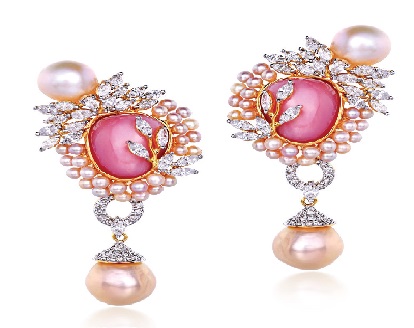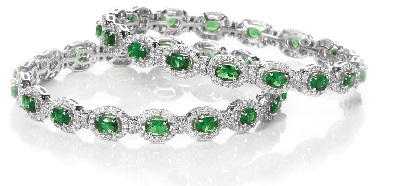How manufacturers look at design & saleability

Designer jewellery manufacturers share their experience of creating some outstanding pieces of jewellery – the challenges involved, how they strike a balance between creativity & saleability and more with Sugandha R
Think jewellery and your mind is filled with images of shiny outof- the-world necklaces, pendants, bracelets, bangles, brooches and more. These breathtakingly shiny objects of desire are created by designers who breathe life into abstract ideas to create masterpieces, which women across the globe flaunt so gleefully.
Jewellery design primarily involves the ability to imagine the finished product in detail – not just the aesthetic aspects, jewellery is meant to be worn, so it has to be functional as well. So one has to imagine it in detail Dheeraj Menda, Studio Rêves
Every step is challenging
The first step is to understand for whom for what occasion. “Before designing a collection we make a detailed effort to understand what customers want, their preferences, current market trends, et al. For instance, currently coloured stones are used and preferred in jewellery. There is a good demand for coloured stones,” informs Ashish Goyal, Kotawala Fine Jewels.
Before designing a collection we make a detailed effort to understand what customers want, their preferences, current market trends, et al. For instance, currently, coloured stones are used and preferred in jewellery. Ashish Goyal, Kotawala Fine Jewels
The first challenge is being able to imagine the whole product in every detail before putting it on paper. Then most manufacturers work backwards, draw out a detailed structure and then comes the next challenge to select the material for making the piece they have so beautifully sketched out. “Once I had made a maple leaf pendant in titanium and gold, studded with diamonds and coloured stones. Every step of the process was challenging and the end result looked marvelous. The whole process from imagination to making the final product was indeed quite challenging and therefore exciting,” explains Dheeraj.
Every collection is unique and therefore needs a different skill set to make. “Launching a whole new collection is mostly intuition based and is influenced by the core idea or theme, technique or application that comes to my mind. There are no hard and fast rules here, it is a sublime process and takes a while to really materialize,” explains Nidhi Garodia, Sanskriti Jewels. Research before launching a jewellery collection is a must, it basically involves: identifying the market need, recognizing what is missing, which could be a colour, concept, product, etc. “An astute businessman can never leave out the business angle. Every collection is meant to be sold, a manufacturer does not launch collections in order to quench his creative thirst only. It has to be saleable and ensuring saleability of products is an important challenge that every manufacturer addresses,” explains Nitin Gilara, Rambhajo’s.
An astute businessman can never leave out the business angle. Every collection is meant to be sold, a manufacturer does not launch collections only in order to quench his creative thirst. It has to be saleable and ensuring saleability of products is an important challenge that every manufacturer addresses. Nitin Gilara, Rambhajo’s

Inspiration can strike anywhere
The world is filled with inspiring ideas – from Nature, architecture, culture, History, inspiration is found anywhere and everywhere. “What is important is how the designer transforms that imagination into a wearable piece of jewellery which will gracefully complement any dress or woman of any age,” explains Nidhi. Some designers are particular about detailing. “I study the subject very carefully, its shades, structure, shape and more. I then study the material that I could use to create it.
My designs revolve around different coloured stones. So I try to procure choicest of coloured stones. The rose-cuts that I use will be different, we change traditional ideas of Even the chakri we use is different. None of my pieces will be identical. Then when these unique and intricately cut pieces are brought together the final product becomes absolutely stunning. We also pay attention to the sajavat of the jewellery and all of this attracts the consumer. Nidhish Lotia, Neetti Designer Jewellery
Gold, of course, is my go-to metal. But I also experiment with other material like wood, oil paints, glass... it depends on the subject. Material is decided later. And yes, there are times when a particular material appeals to me and then I begin to design around it. It is a fluid process,” says Anand Shah of Anand Shah Jewels.
Uniqueness is also a challenge, in this world filled with intense competition. “None of our pieces are repeated, the elements but my be common, my designs revolve around different coloured stones. So I try to procure choicest of coloured stones. The rose-cuts that I use will be different, we change traditional ideas of design even the chakri we use is different. None of my pieces will be identical. Then when these unique and intricately cut pieces are brought together the final product becomes absolutely stunning. We also pay attention to the sajavat of the jewellery and all of this attracts the consumer,” informs Nidhish Lotia of Neetti Designer Jewellery.He asserts that while creating a piece of jewellery he focuses only on design and not on saleability of the product. “Over the years, my karigars understand my design language and there is a lot of back and forth that happens in terms of the finish, enamels, gem setting, the curves of the piece and more. I am an impatient artist and I like to see my concept turn into a beautiful creation as soon as possible,” says Anand Shah.
Gold, of course, is my go-to metal. But I also experiment with other material like wood, oil paints, glass... it depends on the subject. Material is decided later. And yes, there are times when a particular material appeals to me and then I begin to design around it. It is a fluid process Anand Shah, Anand Shah Jewels
The Saleability factor
The saleability factor comes in at a much later stage. “Once the design is finalized then we think of what coloured stones of what quality to use and the metal required to make the jewellery. We have to ensure that the cost of every element is in check. Making an exorbitantly expensive piece is not wise. The piece should look worthy of the cost of every element that goes into its making,” explains Gilara. One also has to factor in for change in prices of individual elements, which has to be affordable. “Today the line between price and pricelessness of a piece of jewellery is indeed too thin,” explains Dheeraj. Also, exquisiteness and perfection are matters of creativity after which the business aspect will be taken into consideration. “If you make sure that you are offering unbounded creativity by balancing it along with the wearability and pricepoint of the product; then saleability won’t be a problem,” believes Nidhi.
“Undoubtedly there is a market share for unique and out of the box designer products and you have such clients too. If one understands these aspects, he will pitch it to his clients,” Nidhi adds. While Dheeraj words it as: ‘This is precisely where pricelessness and price come into play. Creativity is priceless and product always will have a price tag.’ Only when you make these products available and visible at your store, you would be able to address customer’s needs. Therefore, manufacturers ought to make sure that their products are balancing out both these aspects well.
Launching a whole new collection is mostly intuition-based and is influenced by the core idea or theme, technique or application that comes to my mind. There are no hard and fast rules here, it is a sublime process and takes a while to really materialize. Nidhi Garodia, Sanskriti Jewels

There’s never an end
Creativity is an ongoing process and the excitement is, “To see your imagination take shape in the form of a beautiful piece of jewellery. It is a painstaking and intricate effort and often a teamwork,” explains Nidhish. The taste of the pudding is in eating it – every manufacturer puts in his or her best effort – it is however when the product is sold and appreciated by the ultimate consumer she gets the satisfaction of having created a masterpiece. “Sadly, in jewellery making the manufacturer and designer go unnoticed. You look at a Manish Malhotra lehenga and you are willing to pay any price for it. And go all gaga over the designer’s work. But you have bought a diamond set which adds perhaps a lot of value to your persona and is expensive and can be worn again and again on different occasions yet consumers will not even once want to know the name of the designer,” says Dheeraj.
Be the first to comment